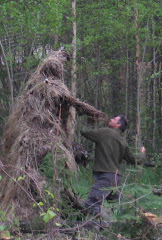(I) couldn't sleep last night. I was tossing and turning as I considered my answer of 200Gb/cm3. Its a real curiosity that the scale of the units actually determines the answer sort of. This is kind of unique. If one is determining a density, the mass per volume ratio will always be the same regardless if one uses say cm3 or m3 because the mass will change accordingly. However in this calcaulation, this is not the case. This is owing to the peculiar fact that reality has different ratios of surface area to volume. The larger the volume, the smaller the ratio of surface area to volume. This ratio follows a parabolic curve where at say km3 its a small ratio getting larger and then smaller again at the mm3 scale. This is due of course to the more non-stuff that a large(km3) volume contains. The question that arises is: does the non-stuff in reality contain information?
For example, let us suppose that we hold a coffee cup at a distance D such that it occupies 10 degrees of vision. We can calculate the information that is contained by the cup but if we stray to say 11 degrees, we are looking through nothing but eventually our eye falls on something behind the nothing, say like the wall in front of me. In this sense, there is no such thing as nothing as far as the visual field is concerned. Does this mean that one no longer need concern themselves with scale issues of surface area to volume ratios? I think the answer is yes because what emerges here is the peculiar notion that the information in the visual field is actually a 2 dimensional field that is wrapped around a 3 dimensional matrix. Put another way, it is a 2 dimensional construct that folds in upon itself. But says the mathematician, you still have the same problem, clearly cm3 of a flat table top folds less than say a m3 of say jungle where the surface area to volume is much higher.
This problem can be encapsulated by T (time.) At any discrete value of T, the visual field can be considered entirely 2 dimensional like a picture. Remembering the coffee cup where essentially there was no discrimination between stuff and non stuff. At discrete values of T, the visual field's unfolded componants contribute no information. Our brain interprets this data into a 3d representation. During interaction (interaction implies T1,T2,Tn) with stuff, we experience the 2d visual field folded in on itself but that is while T= T1+Tn. The value of 200 GB/cm3 then is only valid at the cm3 scale. If we wish to make a calculation that is valid at any scale, we must change cm3 to cm2 and then multiply by T. In this way one is capturing the 2d world streatched over the 3d matrix. Additionaly, T respresents minimum disernable quanta of time which is problematic if not outright existentially impossible. However, its also a potential since visual data at T1 may in fact be the same as T2 so we need not tie ourselves in a knot about time but instead use as a value the saccade rate. Putting all this together, we have now closely translated how the 2d visual field unfolds itself from its pan dimensional state without the problem of a high variance in surface to volume ratios. I was thinking of this in bed so I havn't done the math yet to see what this new answer is. I hope this silly thought experiment and this silly update is good for a laugh if not a strange idea or two.

Subscribe to:
Post Comments (Atom)


3 comments:
What it makes me wonder is why when we have coffee all we ever talk about is Bladerunner and that goofy almond stuff you drink.
I'm somewhat lost here: you wanted to know how much information reality contained, and then you get sidetracked by the task of figuring out how much information is available to a human (non-invasively). But then I read back and see that this is a sub-problem, so maybe not so confused.
I picked up Kurzweil's new book (I might review it on my blog), "The Singularity is Near", and he calculates a minimum information density for a kg rock to be 10^27 bits, and that it can perform at least 10^42 changes in state per second, considering EM interactions alone. This works out to roughly 10^24 bytes/cc, 10^39 cps/cc. (This seemed large until I found that 3 years ago I had "designed" a future bio-chip that was only 6 magnitudes off, and I handicapped myself by both shielding for electron tunneling effects and only considering one mode of info storage.)
If we take as an approximation to 2D space a thin slice 1 micrometer thick, the info density of 1cm2 is 10^8 terabytes, executing 10^35 cps, and it's all energy maximizing parallel processing. While this isn't human information, and not a human scale, it is a rough (and most likely low) approximation to Nature's evolution-wise scale.
This probably doesn't help you very much, but I'm a bit closer to understanding how life could arise from non-life.
In a very real sense I am glad that I dropped out of calculus before I could become sidetracked by issues of this sort. Now, about that almond drink...
Post a Comment